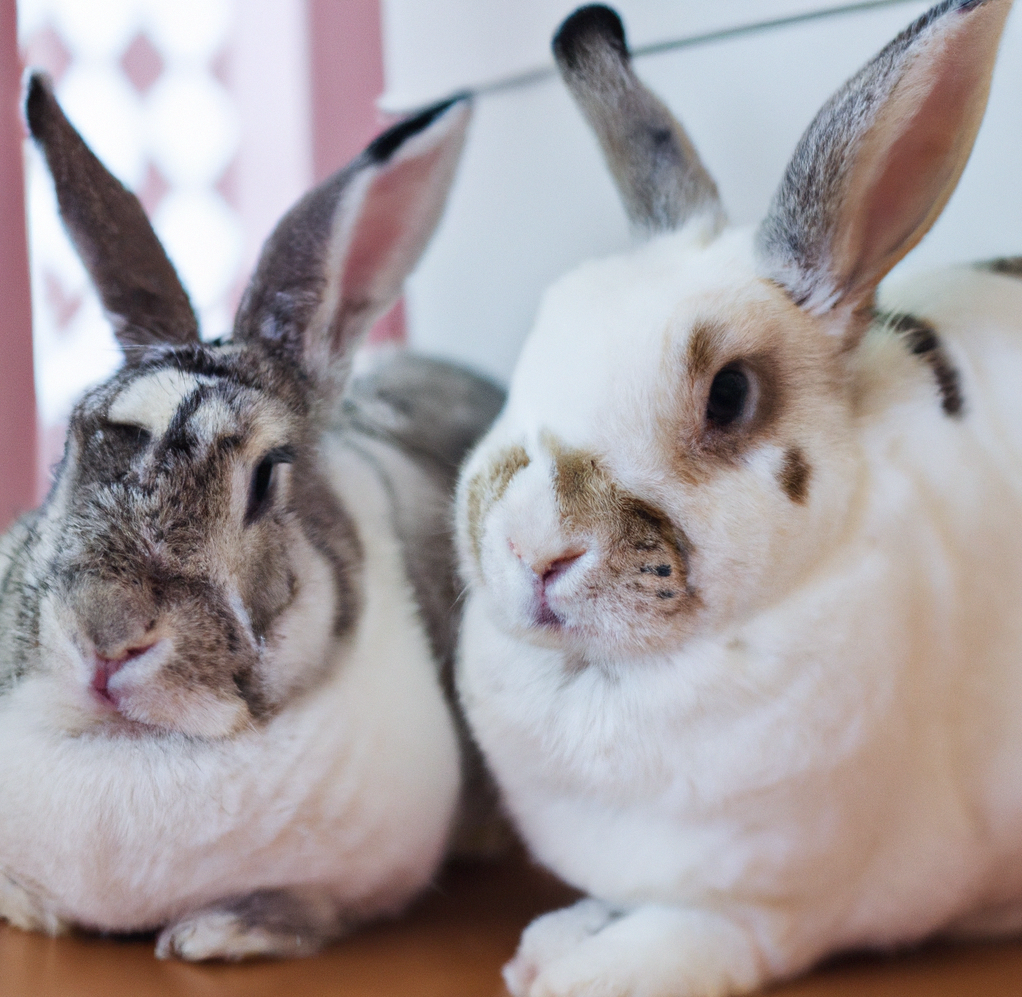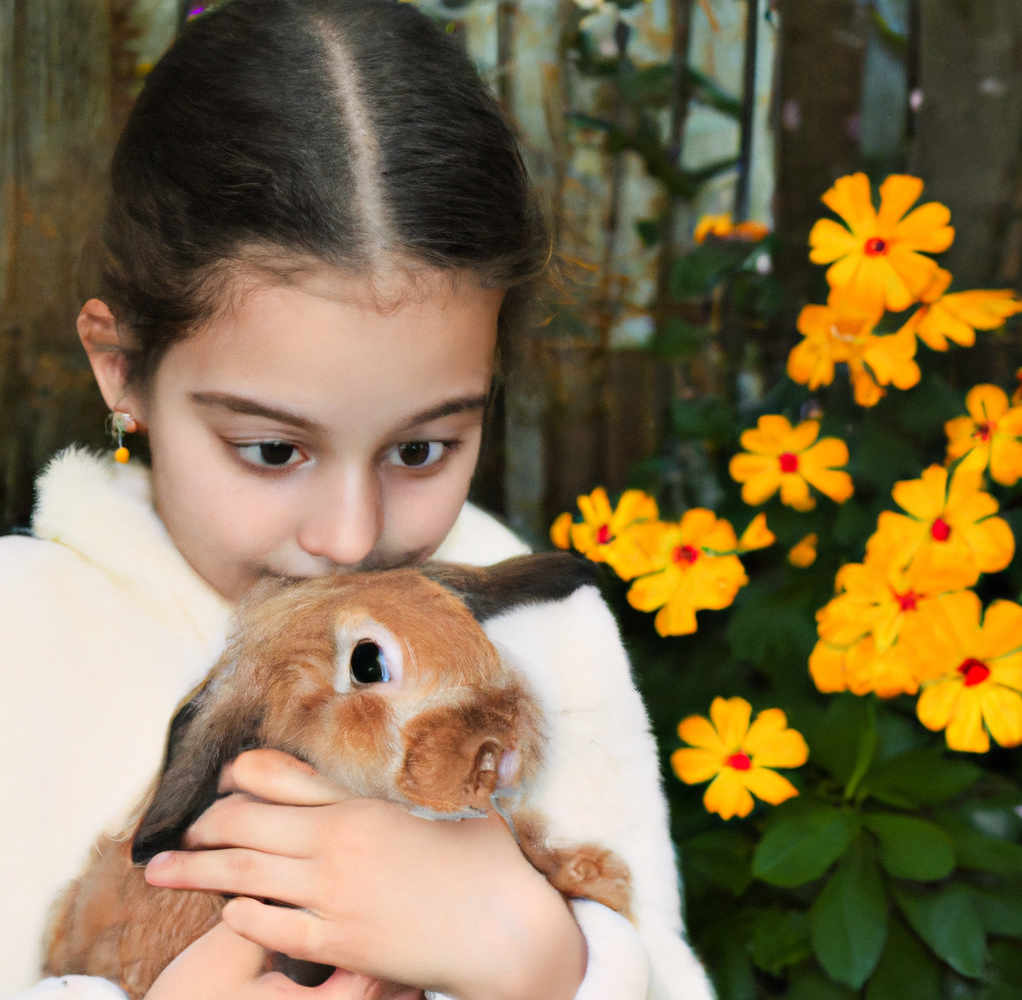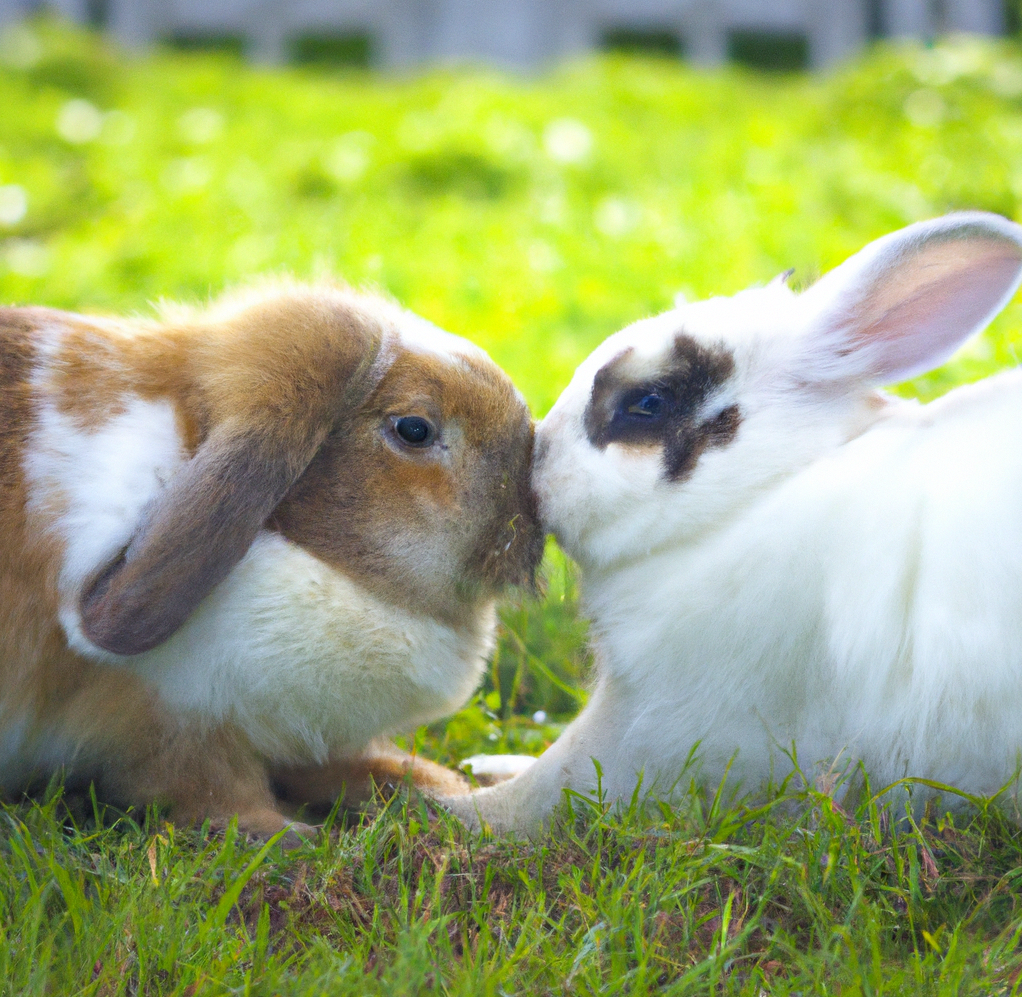Rabbits are social animals and can form strong bonds with their human companions. Bonding with a rabbit can be a very rewarding experience and can lead to a close and loving relationship. There are many positive signs which indicate that a bond is forming between a rabbit and its caretaker. These signs include mutual grooming, nuzzling, and an overall relaxed demeanor. Other signs include hopping around and being vocal, which may be more subtle indicators of a strong bond. By understanding the signs of rabbit bonding, owners can better appreciate the connection between them and their beloved pet.
Bonding Through Cuddling: How Rabbits Show Affection
Rabbits are known for being cute, cuddly animals that are often kept as beloved pets. While they can be quite active, they also enjoy spending time snuggling with their owners. In fact, cuddling is one of the main ways in which rabbits show their affection.
Rabbits are social creatures, and they are naturally inclined to form strong bonds with their owners. When they cuddle, they are not only seeking warmth and comfort, but they are also expressing their love and loyalty. Cuddling helps rabbits to feel safe and secure, and it can also be a way for them to bond with their owners.
When rabbits cuddle, they often do so in a certain position. They will typically curl up into a tight ball with their head tucked under their front legs and their paws tucked close to their body. This position helps them to feel secure and to conserve body heat. They may also lay their ears back and close their eyes in order to block out the light.
Rabbits show their affection by grooming one another, and cuddling is often a way for them to do this. When two rabbits cuddle together, one of them may groom the other by licking and nibbling on its fur. This is a sign of trust and affection, and it can help to strengthen the bond between them.
Rabbits also show their affection by snuggling up against their owners. This usually involves them pressing their face and body against their owners while they lay down. This is a sign of trust and love, and it can be a very special way for them to bond.
Rabbits are naturally social animals, and cuddling is one of the main ways in which they show their affection. They often curl up into a tight ball while they cuddle, and they may even groom one another as a sign of trust. Cuddling is a very special way for rabbits to bond with their owners, and it can help to strengthen the bond between them.
How to Tell if Your Rabbit Wants to Play?

Rabbits are social animals, and they can quickly become bored if they don’t receive enough stimulation. As such, it’s important to know the signs that your rabbit wants to play.
One of the most obvious signs that your rabbit is ready to play is that he will run around his cage or enclosure. He may also hop around and move his ears in an excited manner. Other signs include flopping on the ground and making small jumps. If your rabbit is particularly fond of a certain toy, he may also bring it to you to show that he wants to play.
When your rabbit is ready to play, it’s important to interact with him in a way that is both safe and enjoyable. Try offering him treats, such as pieces of fruit or vegetables, to entice him to play. You can also offer him toys, such as balls or stuffed animals, to keep him entertained. Make sure to interact with him in a gentle manner and avoid any aggressive behavior.
In addition to physical play, you can also engage your rabbit in mental stimulation. Try hiding treats around his enclosure or giving him puzzles to solve. This will help keep him engaged and entertained.
By being aware of the signs that your rabbit wants to play, you can provide him with an enriching environment. This will help ensure that your rabbit remains healthy and happy.
Is My Rabbit Bonding With Me?
Bonding with a pet can be a wonderful experience. Rabbits, in particular, can make excellent companions. However, it can be difficult to determine whether your rabbit is bonding with you or not. While it is impossible to know for certain, there are some behaviors that indicate your rabbit is developing a strong bond with you.
One of the first signs that your rabbit is bonding with you is that it will begin to greet you eagerly when you come home from work or school. It may come to you in order to get your attention or to get a treat. Additionally, your rabbit may exhibit signs of comfort when you are near. It may settle into your lap for petting, or it may even follow you around the house.
Another sign that your rabbit is bonding with you is that it will seek out your company. Rabbits are social animals and they will often seek out the attention of their owners. If your rabbit is hopping over to you when you enter the room, then it is likely that it is developing a strong bond with you.
It is also important to look for signs of trust. If your rabbit is not afraid to be picked up or petted by you, then this is a good indication that it trusts you and is comfortable with your presence. Additionally, if your rabbit is willing to share its space with you, then this is another sign that it is bonding with you.
In conclusion, bonding with a rabbit is a wonderful experience. While it is impossible to know for sure whether your rabbit is bonding with you, there are some behaviors that indicate that it is. If your rabbit greets you eagerly when you come home, seeks out your company, and shows signs of trust when you are around, then it is likely that it is bonding with you.
Understanding Rabbit Body Language: What Does it Mean?

Rabbit body language can be an important tool for understanding how a rabbit is feeling. Rabbits communicate their emotions through a variety of physical cues, including ear and tail positions, facial expressions, and body posture. By paying close attention to a rabbit’s body language, owners can gain insight into their pet’s emotional state and react accordingly.
A relaxed rabbit will have its ears perked up and eyes wide open. Its tail will be held up and its body will be calm and its movements will be slow and gentle. This is a good sign that the rabbit is feeling secure and content.
On the other hand, if a rabbit’s ears are flat against its head, its eyes are wide open and its pupils are dilated, its tail is down and its fur is standing on end, it is likely feeling scared or threatened. When this happens, it is important to remove any potential sources of danger so that the rabbit can relax.
Rabbits may also use body language to show dominance over other rabbits. When a rabbit feels dominant, it may posture, with its back arched and its chin held high. It may also thump its hind legs against the ground and make loud, low thumping noises.
Finally, a rabbit may show affection by licking its owner and nuzzling the owner’s hand. It may also rub its chin against the owner’s hand or clothing.
By understanding a rabbit’s body language, owners can ensure that their pet is comfortable and secure. Knowing what different body language signals mean can also help owners better understand their pet’s needs and ensure that it is receiving the best care possible.
Encouraging Positive Bonding With Your Rabbit
Rabbits are social creatures that can form strong bonds with their owners. As such, it is important to encourage positive bonding with your rabbit. Here are some tips to help you create a strong and positive bond with your rabbit.
First, it is important to spend quality time with your rabbit. This could be done through regular playtime, petting, or simply being in the same room as your rabbit. Take the time to allow your rabbit to explore their environment, and get to know you.
Second, offer your rabbit treats as a way of showing your affection. This could range from hay cubes, to vegetables, to small pieces of fruit. Be sure to only give treats in moderation, as too much of a good thing can be bad for your rabbit’s health.
Third, create an environment that your rabbit feels comfortable in. This means providing your rabbit with plenty of space, a litter box, and plenty of toys. Make sure that the temperature and humidity in your rabbit’s environment are comfortable, and that the environment is free of noise and distractions.
Finally, be patient when bonding with your rabbit. Building a bond takes time, and rabbits can be easily spooked. Allow your rabbit to come to you, rather than overwhelming them with too much attention.
By following these tips, you can create a strong and positive bond with your rabbit. With patience, dedication, and love, you can create a lasting bond with your rabbit that will provide years of joy and companionship.
Rabbit Bonding Through Mutual Grooming
Rabbit bonding through mutual grooming is a behavior that occurs between two rabbits when one of them grooms another. This behavior serves both to strengthen the bond between the two animals and to maintain their overall health.
Grooming is an important part of a rabbit’s daily routine and is usually performed by the rabbit itself. However, when two rabbits are in close proximity, they may engage in mutual grooming. During mutual grooming, the rabbits will use their front paws to gently caress the other rabbit’s head, neck, and ears. They may also lick and nibble each other’s fur.
Mutual grooming has many benefits for rabbits. It reinforces the bond between them, helps them to relax, and helps to keep their coats healthy and free from debris. It also serves to strengthen their social hierarchy and can help to reduce territorial aggression. Mutual grooming also assists in the maintenance of the rabbits’ overall health by aiding in the removal of parasites, such as fleas and mites.
In order to ensure that mutual grooming is a positive experience for both rabbits, it is important to provide a stress-free environment for them. This means that their environment should be free of loud noises, sudden movements, and unfamiliar people. Additionally, it is important to ensure that the rabbits have plenty of space to move around and that they have access to plenty of food and water.
By understanding the importance of mutual grooming and providing a stress-free environment, rabbit owners can help to ensure that their animals are able to develop and maintain strong bonds. The bonding that takes place through mutual grooming is an important part of a rabbit’s overall health and well-being.
Tips for Bonding With Your Rabbit in a Natural Environment
1. Create a safe and comfortable environment for your rabbit: Ensure that your rabbit’s environment is clean, spacious, and well-ventilated. Provide plenty of hiding places and toys for your rabbit to explore.
2. Spend time with your rabbit: Spend time interacting with your rabbit each day. Spend time petting your rabbit, talking to it, and playing with it.
3. Offer treats: Offer your rabbit healthy treats like fresh fruits and vegetables to encourage it to come to you and to build trust.
4. Provide enrichment activities: Provide activities that will keep your rabbit mentally and physically stimulated. Enrichment activities can include providing toys, digging boxes, tunnels, and mazes.
5. Respect your rabbit’s space: Respect your rabbit’s boundaries when it comes to petting and handling. Allow your rabbit to come to you and don’t force it to do anything it doesn’t want to do.
6. Handle your rabbit carefully: When handling your rabbit, use gentle, slow movements and support its back and hindquarters.
7. Provide a secure area: Make sure that your rabbit has a secure area that it can retreat to if it feels scared or stressed.
8. Be patient: Bonding with your rabbit takes time and patience. Don’t give up if your rabbit isn’t immediately comfortable with you. With patience and consistency, your rabbit will eventually come to trust and love you.
The Benefits of Bonding With Your Rabbit: Mental and Physical Health
Rabbits are incredibly social animals, and it is essential to spend time bonding with your rabbit in order to help them feel secure and happy. Bonding with your rabbit through regular handling, playtime and cuddles can provide numerous mental and physical health benefits.
Regular handling and cuddles help to create a strong bond between you and your rabbit. This bond can help to reduce your rabbit’s stress and anxiety levels, making them feel secure and contented in their environment. Rabbits that are regularly handled are also less likely to become aggressive or scared of human contact. Handling your rabbit also allows you to check their body condition, and gives you the opportunity to spot any potential health issues early on.
Playtime is a great way to bond with your rabbit while providing them with some much-needed exercise. Rabbits that get plenty of exercise tend to be healthier and happier than rabbits that don’t get the chance to move around much. Playing with your rabbit can also help to stimulate their minds, which will help to reduce boredom and may even prevent destructive behaviour.
Bonding with your rabbit is not only beneficial for their mental health, but it can also help to keep them physically healthy. When rabbits are happy and content, they are more likely to eat well and groom themselves properly, which helps to keep their coat in good condition and their digestive system functioning properly. Regular handling also helps to build muscle and strengthen bones, which can help to prevent musculoskeletal problems such as arthritis.
In conclusion, bonding with your rabbit through regular handling, playtime and cuddles can provide numerous mental and physical health benefits. Not only does it help to create a strong bond between you and your rabbit, but it also helps to keep them physically healthy and mentally content.
Conclusion
The positive signs of rabbit bonding show that rabbits can form strong social bonds with other rabbits and humans. With patience, understanding, and proper care, rabbits can become a beloved part of the family. With the right environment and socialization, rabbits can be great companions and provide lots of love and joy. Although it can take some time, rabbits can form strong and lasting bonds with each other and their human caretakers.

